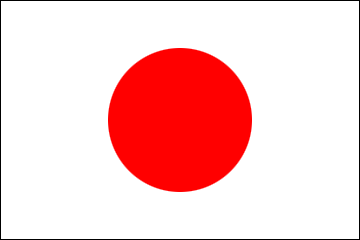Japan Travel Talk No. 4 – Sumo & Tokyo
2020/3/13

|
No. 4 – Sumo & Tokyo
For fans of sumo, arguably Japan’s most recognizable sport around the world, a new year means it’s time for the Tokyo Grand Sumo Tournament, held every January at the Ryogoku Kokugikan Stadium (the 2020 tournament ended on January 26). This is one of six tournaments held throughout the year: three in Tokyo and one each in Nagoya, Osaka, and Fukuoka. While Ryogoku is closely associated with sumo, the neighborhood and its surroundings also offer many interesting attractions for experiencing both modern and traditional charms of Tokyo’s Shitamachi area.
|
Sumo Match 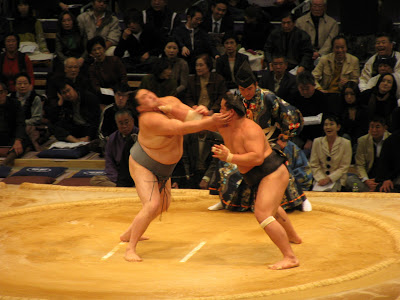 Photo by Lars Henriksen |
| First, here are some basics about sumo, courtesy of Consulate staff member and sumo spectator Lars Henriksen. Elements of sumo have existed in some form for over a thousand years but the sport evolved into its modern form mostly during Japan’s Edo period. In sumo, two wrestlers, or rikishi in Japanese, face off in a special ring built on a clay mound called the dohyo and encircled by ropes made of rice straw. Above the dohyo, which is specially-built using traditional methods in the days leading up a tournament, is a structure that resembles the roof of a Shinto shrine. Using a variety of techniques, the goal is to force your opponent outside the ring or force any other body part of theirs besides the feet to the ground inside the ring. Wrestlers are divided into different classes based on skill level, and the top-ranked yokozuna* wrestlers perform elaborate ceremonies wearing colorful aprons at the start of the final matches. You may also notice wrestlers throwing handfuls of salt in the rings before a bout in a ritual to purify the dohyo and bring protection from injury. The grand tournaments last for about two weeks and affordable seats are typically obtainable at the stadiums. *See trivia at the bottom |
Tsuriyane Roof Suspended over the Dohyo Ring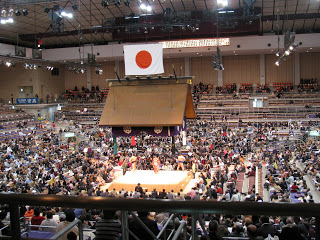 Photo by Lars Henriksen |
Yokozuna in Ceremonial Aprons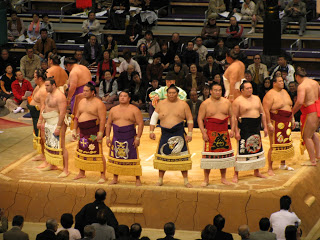 Photo by Lars Henriksen |
Kokugikan, the national sports stadium that hosts the Tokyo’s Grand Tournament, has a distinct pyramidal roof that makes the graceful structure a landmark in the Ryogoku neighborhood. You will also find the Japan Sumo Museum inside the Kokugikan. Nearby in a massive, seemingly floating structure is the wonderful Edo-Tokyo Museum that tells the story of Japan’s capital city since the late 1500s with immersive scale models, life-size recreations, and a wealth of artifacts. Of course, if you are looking to feast like a sumo wrestler, Ryogoku is also the place to find a hearty stew called chanko nabe that provides the protein and calories necessary for maintaining a hefty physique. This and other traditional Edo cuisine can be enjoyed at the -Ryogoku- Edo Noren shopping and dining complex, located in the former JR Ryogoku station house built in 1929, and complete with its own sumo dohyo on display in the central atrium. |
|
Yokozuna in Ceremonial Aprons
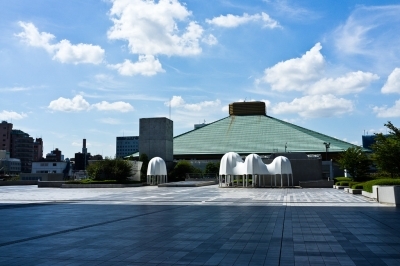 Photo by Lars Henriksen
Edo-Tokyo Museum 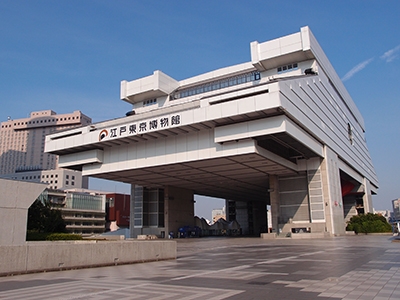 Photo by Guilhem Vellut |
Yokozuna in Ceremonial Aprons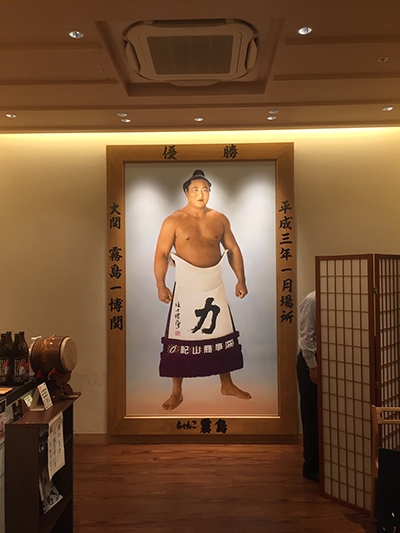 Photo by Travis Doty |
|
Up the Sumida River from Ryogoku is Tokyo’s oldest temple Sensō-ji in Asakusa, and the Tokyo Skytree is not far away, too. In fact, a water-taxi service between Asakusa and Tokyo Bay along the Sumida River, which passes by Ryogoku, is a relaxing way to take in some of the sights mentioned in this article.
Traditional Asakusa Shopping Street with SkyTree in the background 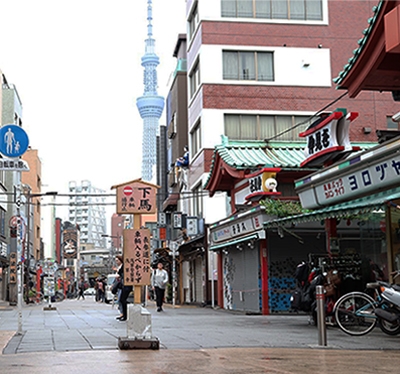 Photo by Travis Doty |
Sensō-ji Temple on a Rainy Day 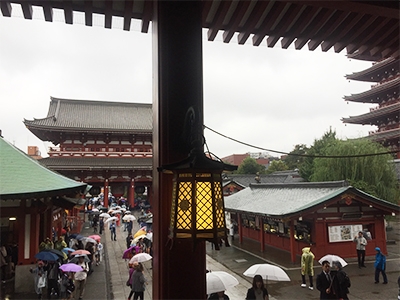 Photo by Travis Doty |
Trip Resources
| Nihon Sumo Kyokai - Sumo Tournament Information and Tickets |
http://www.sumo.or.jp/En/ |
| Edo-Tokyo Museum | https://www.edo-tokyo-museum.or.jp/en/ |
| Ryogoku and Asakusa Area | https://www.japan.travel/en/destinations/kanto/tokyo/ryogoku/ |
| Guides | https://www.mhi.com/expertise/museum/mrj/https://www.japan.travel/en/ destinations/ kanto/tokyo/asakusa-and-around/ |
| http://visit-sumida.jp.e.ux.hp.transer.com/ | |
| Ryogoku- Edo Noren | http://www.jrtk.jp.e.wz.hp.transer.com/edonoren/ |
| Sensō-ji temple | http://www.senso-ji.jp/english/ |
| Tokyo Skytree | http://www.tokyo-skytree.jp/en/ |
| Water Taxis | https://www.suijobus.co.jp/english/ |
| http://www.tokyo-park.or.jp/waterbus/ | |
Japan Travel Trivia
| Professional sumo wrestlers (rikishi) are divided into six divisions, and further ranked within their division based on win-loss results. The top rikishi of the top division (makuuchi) are the grand champions called yokozuna, which refers to the large, ceremonial rope worn around the waist – see photo on the right. Lower in the Makuuchi division are the rikishi with maegashira ranking, including the popular wrestler Terutsuyoshi, who is from Washington’s sister-state of Hyogo, Japan, and was born just hours after and at the epicenter of the Great Hanshin-Awaji Earthquake in January 1995. Terutsuyoshi, a ring name that means ‘strongly illuminating the surroundings,’ certainly is a beacon of pride for his home region over the past twenty-five years of its rebuilding. You can learn all about professional rikishi like Terutsuyoshi here: http://www.sumo.or.jp/EnSumoDataRikishi/search/ |
Dohyo-iri Ceremony by Yokozuna 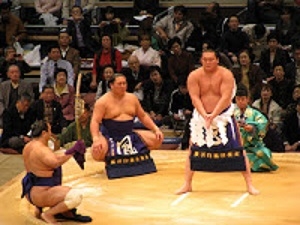 Photo by Lars Henriksen |
Remember to send us your questions and suggestions for topics that you would like us to cover. You can email our info address (info@se.mofa.go.jp) with the subject line “Japan Travel Talk” or post comments on our Facebook page.
See you soon!
Japan Travel Talk Team
Japan Travel Talk Team
